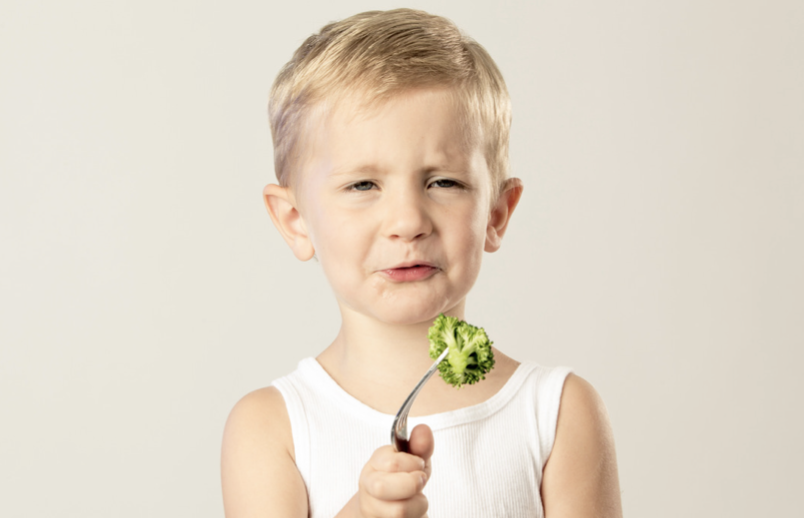How To Help Fussy Eaters

How can I help my picky eater?
The most effective method for encouraging children to explore new foods is continued exposure. Our kids need to be exposed to a ‘new’ food approximately 10 times before they will consider tasting it – so if you find yourself putting foods on plates KNOWING that it’s probably not going to be eaten, you’re actually taking a positive step in the right direction!
Don’t panic.
We want new foods to be a positive experience. Dinner time isn’t the time to get angry and frustrated. Pushing foods on kids or using threats turns meal times into a stressful situation for the whole family. Unfortunately, this can actually contribute to the negative emotions surrounding new foods or particular meals, which can continue the cycle of picky eating and lead to restrictive eating behaviour later in life.
So, how do you get a fussy eater to eat?
- Don’t take away safe foods in the hope that children will then eat something else. Again, we want this process to be positive – we don’t want new foods to be a source of stress and anxiety.
- New foods shouldn’t be the reason safe foods are being withheld. Serve the safe foods, and have new foods available.
- Where possible, everyone in the family is served the same options during meal times.
- Involve children in the process. Farmers markets, grocery shopping (even selecting which foods for an online grocery order), helping to prepare meals and snacks are all great ways to create positive relationships with food.
- Results won’t happen overnight; this will take time. In a way, trying new foods is a journey that continues into adulthood – that’s why it’s so important to take steps to make this process a positive experience.
- Be honest. Personally, I don’t actually enjoy salad. It’s cold and I’ve never enjoyed raw veggies. Look for different ways to prepare and include vegetables in meals (if you need help, reach out, that’s what I’m here for). Also, be honest about why you eat a particular food, even if you don’t really enjoy it. Fair enough, you know cucumber is good for you – but do you know why? Do you know why it’s good for your child, and do you know how to communicate that to them in an age appropriate way?
How can we stop kids from wasting food?
There are some simple ways to avoid this. Personally, I love communal dishes on the dinner table. Everyone has their own plate, and selects foods off the main dishes from the middle of the table. Again, the first step here is exposure, you don’t want to start this process guns blazing and instructing kids to grab 3 pieces of broccoli and put it on their plate. The adults do this, and set the example.
The benefit to communal plates is that at the end of the meal, leftovers can be packed and stored for lunch the next day.
Another tactic I use with my own kids is wrapping up their leftovers so they can have the remainder when they’re hungry again.
“You don’t want to eat? That’s fine, no problem at all! I can just put it in the fridge and that’s what you can have when you’re hungry next.”
Encourage autonomy in children.
Around age two, our children begin to develop body autonomy – they want to make decisions that concern them for themselves. This is an important developmental milestone, so I actually recommend taking a step back and giving some decision making power to the little people.
Let them decide what kind, or how many fruits and vegetables they want to put on their plate or lunchbox – “do you want cucumbers or tomatoes toady? “Have you chosen a piece of fruit from the fruit bowl, or would you like to choose something from the fridge?”
You’re still in charge, but they have options.
The importance of family meal times.
I can say this until I’m blue in the face – monkey see, monkey do. If you’re eating veggies, your child is going to feel more inclined to do the same. This is where family meal times can be a fantastic way to portray that positive relationship with food. This gives the adults the opportunity to show that they themselves have a positive relationship with food, and feel good about eating a meal together as a family.
What to do if your child still isn’t eating.
Nutritional deficiencies can actually change the way our children experience taste. If there’s no vibrancy to the way foods taste, there isn’t much enjoyment in trying new foods.
Nutritional deficiencies can also contribute to sensory feeding issues, such as aversions to different textures and temperatures.
Where there is restrictive feeding issues, there are often nutritional deficiencies. Identifying these deficiencies, correcting them, and then taking steps to reduce the risk of it happening again is a fundamental part of nutritional medicine.
If you still feel like you’re at a loss, get in touch.
– Ash Yates, Children’s Health Naturopath.






